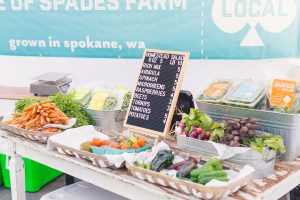The environment in your neighborhood and surrounding community has a huge impact on your health and lifespan. Where you live determines how safe your drinking water is, whether you have access to healthy food, how often you get outdoors to exercise and whether you breathe clean air.
In fact, an health statistics show that social factors, like your physical environment and quality of support services, account for over 50 percent of total deaths a year in Nigeria. That is, people living in dilapidated neighborhoods with fewer public services, safe spaces and supportive social networks are more likely to suffer poor health and premature death.
With poor health policies and corrupt public health officials perverting the course of quality living, there are plenty of smaller things you and your neighbors can start doing right now to help make your neighborhood healthier. Here are 10 ideas to help you and everyone around you live better and longer.
1. Grow healthy food

Garden-fresh fruits and vegetables grown naturally in your backyard with homemade compost and without synthetic pesticides or fertilizers are more nutritious than refrigerated produce shipped from long distances. Less reliance on transportation also means lower fossil-fuel use and fewer carbon emissions that cause health-harming climate change. Organize a healthy produce swap with neighbors who also have gardens or start a community garden. You can even use an empty lot.
If gardening isn’t popular or doable in your neighborhood, start a centrally located farmer’s market or buy a bulk membership in a CSA (community-supported agriculture) to get farm-fresh seasonal produce for you and your neighbors. Also ask local grocery stores, restaurants and schools to offer more healthy food and drink options.
2. Make your community more walkable and bikeable.
Each hour you spend in a car per day corresponds with a 6 percent increase in your odds of becoming obese. Obesity is linked to many chronic and deadly diseases. Too many vehicles on the road also leads to stressful traffic congestion, unhealthy greenhouse-gas emissions and accidents that injure and kill people and animals.
To make your community healthier and safer, advocate to make it more walkable and bikeable. Work with local officials to create pedestrian and bike zones. Ask for bike racks around town. Set up a “walking bus” where parents take turns escorting kids to and from school. Lobby for speed bumps, elevated crosswalks, lower speed limits and other traffic-calming designs to slow down drivers. Even small decreases save lives, as evidenced by a 2011 study from AAA which found you’re nearly 70 percent more likely to be killed if you’re struck by a car going 30 mph than by one going 25 mph. If you can’t walk or bike, consider carpooling.
3. Shop local

Buying from businesses in your community doesn’t just help them thrive, it also helps you and your neighbors in a number of health-promoting ways. For one thing, if stores are nearby you can walk or bike there, improving your physical fitness and reducing car use (see the previous tip). When shops are close and goods aren’t shipped from far away you minimize traffic jams, energy consumption, carbon emissions and habitat loss from sprawl. In addition, supporting community merchants strengthens the local economy, which in turn improves the health of your neighborhood and saves lives. Lower income and economic insecurity is widely linked to poorer health and lower mental well-being.
4. Reduce neighborhood waste
Litter isn’t just unsightly, it’s also dangerous for kids, wildlife and everybody else in your neighborhood. Improperly discarded cigarette butts, old tires, junk food wrappers, plastic soda rings, beer cans, chemicals and other trash can hurt or kill animals, start fires, promote harmful bacteria and clog stormwater drains (which causes flooding and contaminates groundwater).
Pick up trash when you see it or organize regular neighborhood cleanups. Start a compost pile in your yard instead of dumping food scraps and yard waste in the garbage, or set up a community compost center. Composting not only transforms waste into healthy nutrient-rich soil for your yard and garden, but it also cuts greenhouse gas emissions from the breakdown of organic matter in landfills and from fuel used to transport waste.
5. Plant trees

Besides absorbing air pollutants and carbon dioxide, protecting against climate change and providing oxygen, trees add to the health of humans, wildlife and neighborhoods in many additional ways. Plant trees in your yard (preferably native varieties adapted to soil and climate conditions) and encourage your neighbors to do the same. Consider organizing a community tree-planting project. Many cities and tree organizations like National Wildlife Federation’s Trees for Life program give away free seedlings to groups.
6. Encourage development of parks and outdoor spaces
Nature, trees and undeveloped fields and forests are good for your body and mind, according to several studies. It’s not just that they encourage you to get outside and move. Being in nature also cuts blood pressure, lowers the body-damaging impact of stress and promotes psychological well-being. Hospital patients who have a view of trees even tolerate pain better and go home faster.
Team up with community leaders to preserve green spaces, create parks, develop biking and walking paths, and establish more outdoor recreational areas. If you live in an urban neighborhood without many green spots encourage nearby schools, churches and community centers to open their playgrounds and other recreational spaces to local residents when not in use. Ask about indoor gyms, play areas, pools and even hallways for community use in bad weather.
7. Green the tiny spaces too
We all know those spots that could become real community assets with a little TLC. Maybe there’s an eyesore vacant lot that might be transformed into a public meditation garden or sitting park. Or how about that little strip of land between the sidewalk and curb that you and your neighbors could convert into a rain garden to absorb storm-water runoff and filter out chemicals, pesticides and other pollutants? Create a bigger rain garden in your yard to soak up rainwater from your downspouts, and urge your neighbors to follow suit.
8. Volunteer in your community
Join a group that’s working to make your community healthier — whether that’s providing nutritious meals to older neighbors, fighting poverty or improving the environment in your area. Other ways to get involved include attending municipal meetings, writing letters to community leaders, getting appointed or elected to a town board such as the planning commission, and even running for city council or other local office. Not only will you be directly involved in decision-making about your community’s growth, open spaces, parks and other services that affect health, but studies show that volunteering also boosts your own physical and mental health. All the more reason to encourage your neighbors to get involved too.
9. Clean up your energy use
Installing solar panels on your home allows you to generate electricity without producing harmful greenhouse gas emissions. Too expensive? Do a bulk purchase with your neighbors and receive a discount. Solar co-ops like DC Sun allow communities to collectively green their energy use. If wind energy is more appealing, consider installing a small wind turbine on your property. Even better, organize your neighbors to create a community-owned wind farm.
10. Be neighborly
Research shows that connecting with people around you makes you healthier and boosts your lifespan. Specifically, studies show that having a strong social network helps cut stress levels that can harm your immune system, coronary arteries and gut function, plus it elevates stress-busting hormones.
Introduce yourself to neighbors and stay in regular touch. Create a welcoming front porch and reach out to passersby. Or put an outdoor lounging space in your front yard instead of the back yard to improve your approachability. Organize a neighborhood party. Keep your community even healthier by creating a neighborhood “care watch” committee that provides local residents in need with home-delivered meals, rides to the doctor and help with everyday tasks.

